ASM Metals HandBook Vol. 8 - Mechanical Testing and Evaluation
Подождите немного. Документ загружается.


variable, but a typical test can last up to 2 minutes. However, the test time ultimately depends on the hardness
of the material being tested and the type and size of abrasive particle being used. After the operating conditions
have been determined, a test cycle is run on the three samples. After each test cycle, the samples are moved,
ultrasonically cleaned in alcohol, and dried. Mass loss is determined for each sample, and the average value is
used to calculate a wear rate from one of the equations in Table 3. If needed, a second, third, or additional wear
cycle is run to achieve the precision and accuracy required.
In the case of the pin-on-abrasive disk (Ref 42), different fluids, either corrosive or noncorrosive in nature, can
be used so that the effect of corrosion can be investigated while a sample is being abraded. Using ASTM G 119
(Ref 43), the effect of corrosion on wear and wear on corrosion can be determined for a given material. Figure 7
is a schematic representation of the corrosive-abrasive wear apparatus. Although the geometrical configuration
is different from the pin-on-drum in that the pin is abraded against a flat disk of abrasive (in this case, a resin
bonded grinding disk), the same general principles hold as with the pin-on-drum with one exception. In the pin-
on-drum test, the sample is traversed in a helical fashion so that only fresh abrasive is encountered by the pin.
In this test, the pin remains in the same position relative to the disk, but the disk deteriorates with time in such a
manner as to constantly expose fresh abrasive grains for abrasion. The use of a circulating liquid facilitates the
flushing of wear debris from the wear track on the disk. Thus, a wear curve can be generated that shows the
typical linear increase in mass/volume loss with sliding distance (Fig. 8).
Fig. 7 Schematic diagram of pin-on-abrasive disk wear apparatus. I, current; V, potential; N
g
, normal
acceleration (up and down motion of pin specimen as a result of interaction with abrasive disk); f,
frictional force of pin-abrasive disk couple; V
s
, sliding speed of disk. Source: Ref 42
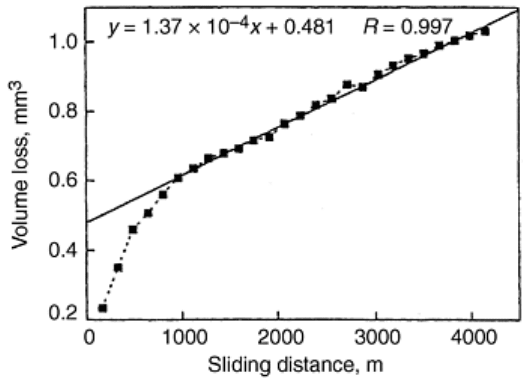
Fig. 8 Wear curve for ASTM A 514, type B low-alloy steel showing nonlinear and linear portions of
volume loss versus sliding distance data. Normal force, 1.4 N (0.3 lbf); sliding speed, 0.1 m/s. Source: Ref
42
The general procedure for performing a wear test is exactly the same as with the other abrasion tests described
so far. The sample is broken in, thoroughly cleaned, dried, and weighed before use. The pin is placed in a
holder, then pressed against the surface of the grinding disk (either alumina or silicon carbide of different grit
sizes), and the deionized circulating water is started. The sliding speed, distance to be traveled, and load are
then selected. The test is run and the mass loss is measured. The wear rate is calculated in the normal way using
one of the equations in Table 3. Research has shown that for any pin specimen-grinding disk couple, a curve of
sliding distance versus cumulative mass/volume loss can be constructed. Typically, there is a nonlinear portion
to the curve at short sliding distances where the pin is conforming to the disk surface. In essence, this test
requires that both the pin and disk be conditioned before recording wear data. Once the nonlinear region has
been identified for a material-disk couple under a specific set of operating conditions, then single-point wear
tests can be subsequently run to determine the wear rate. The use of a deionized water lubricant usually does
not introduce problems in determining the wear rate since the test is short enough (typically 2–3 hours), and the
abrasive wear rate is large enough to obscure the effects of corrosion. However, if another lubricant, either
more acidic or basic, is used, then the test becomes one of abrasion-corrosion. In this case, the component of
corrosion is more significant.
Gouging-Abrasion Wear Testing
Gouging-abrasive wear is identified by the removal of a significant amount of material (a gouge) from the wear
object during an encounter with an abrasive object in which the abrasive object also suffers damage. It is a type
of high-stress wear that may be produced by either two-body or three-body conditions. The jaw crusher test
gives high-stress, three-body abrasive wear. Jaw crusher wear tests were pioneered in the United States by
Borik (Ref 44, 45) and used abroad by Sare and Hall (Ref 46). The jaws that crush the rock are taken as the test
specimen. A number of investigators believe that the jaw crusher test gives the closest correlation to wear that
occurs on earth-penetrating equipment, such as excavator teeth, power shovel buckets, scoops, and grader
blades, as well as real jaw crusher wear.
Jaw Crusher Equipment and Specimen. One test plate and one reference plate are attached to the stationary jaw,
and the other test and reference plates are attached to the movable jaw such that a test plate and a reference
plate oppose each other. A rock hopper and rock chute are attached above the jaw crusher. The arrangement of
the jaw crusher test equipment is shown in Fig. 9.
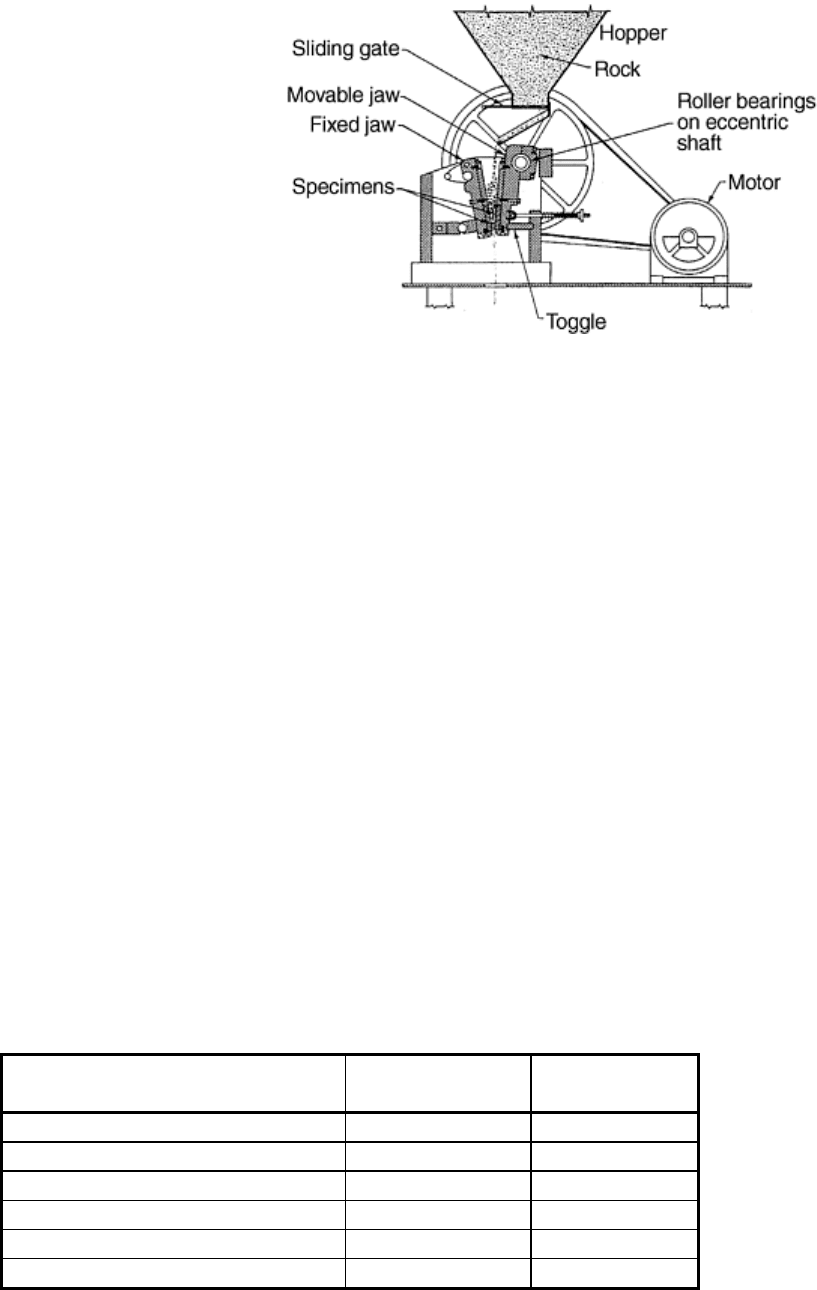
Fig. 9 Schematic diagram of jaw crusher wear apparatus. Source: Ref 47, 49
The test as used provides an average of the mass or volume loss of a pair of test plates, one from the stationary
and the other from the movable jaw of the test machine. As specified by ASTM G 81 (Ref 47), jaw crusher data
are presented as the ratio of the mass loss of the test specimen to that of a reference material. However, there is
some disagreement (Ref 48) regarding the most efficient way to perform multiple tests and interpret the data.
Complete details of the ASTM procedure can be found in Ref 47. The procedure described subsequently is an
alternative test procedure that determines the absolute wear rate for a pair of jaw crusher specimens (Ref 49).
Jaw Crusher Procedure. In the nonstandard ASTM jaw crusher test, a set of four wear plates are cleaned and
weighed and then clamped into the jaws of the jaw crusher (one set of specimens, A and B, in the stationary
jaw, and another set of specimens, B and A, in the movable jaw). One specimen plate in the stationary jaw (A,
for example) opposes that of another specimen (B) in the movable jaw. The minimum jaw opening is set (as per
ASTM standard G 81), and rock is processed through the jaw crusher. The specimens are removed and cleaned
thoroughly to remove any microscopic wear and/or crushed ore debris. The samples are rinsed in ethanol and
then warm air dried. The mass loss is determined for each of the four jaw crusher plates. The samples are then
reversed in the jaw assembly (i.e., the plates in the A position of the stationary jaw are now placed in the A
position of the movable jaw), and the plates in the movable jaw are now placed in the stationary jaw, again in
positions that oppose each other. The assembly is then placed back into the jaw crusher, the gap is reset, and a
second run is made. The samples are once again removed, thoroughly cleaned, dried, and weighed. At this
point, an average of the mass loss during the test is calculated for each of the two plates of the same material.
This value is converted to a volume loss by dividing the mass loss by the density of the material. Table 6 shows
data from both the ASTM method and the method just described.
Table 6 Typical jaw crusher wear data for ferrous alloys
Alloy and designation Hardness
(a)
, HV
Volume loss
(b)
,
mm
3
/kg
Stainless steel, type 304 207
27.7 ± 4.9
Austenitic steel, 13% Mn 230
13.2 ± 2.1
Low-alloy steel, ASTM A 514 256
23.9 ± 3.3
Low-alloy steel, AISI 4340 540
13.8 ± 1.4
Tool steel, type D2 698
15.9 ± 2.5
High-chromium white cast iron
661 15.6 ± 2.2
Tests conducted using high-silica quartzite ore.
(a) Hardness measurements were calculated from the average of ten readings from each wear face of the two
jaw crusher specimens, for a total of 20 measurements.
(b) Volume loss is in cubic millimeters of material lost per kilogram of ore crushed.
In the ASTM procedure, a reference material is run with every test. Therefore, only one specimen material can
be run at a time, and the ratio calculated refers to the wear of the specimen compared with the wear of the
standard. By running the test with a standard material in all positions, the operation of the jaw crusher can be
checked to see whether it still operates within performance limits. By using a nonstandard approach, data from

two sets of test specimens can be obtained during one test. Using reference materials mixed in with the other
specimens will also provide information on whether the jaw crusher is performing within specified limits. An
advantage in using the nonstandard method is that it allows the specimen materials to be matched according to
their hardness so that the wear rates from both sets of materials will be similar in magnitude. Doing this
eliminates the possibility of a softer material wearing at an accelerated rate, skewing the ratio with respect to
the reference material. Another advantage of the jaw crusher is that the abrasive used for the test can be exactly
matched to the field application. Table 7 gives some representative data for different ore types.
Table 7 Jaw crusher wear data for ferrous alloys using different ores
Volume loss, mm
3
/kg
Alloy and
designation
Quartzite
Limestone
Granite
Stainless steel, type 304 27.7 ± 4.9
6.3 ± 0.1
6.3 ± 1.0
Low-alloy steel, ASTM A 514
23.9 ± 3.3
6.1 ± 1.0
6.9 ± 0.5
Low-alloy steel, REM 500 11.3 ± 1.5
1.2 ± 0.0(2)
0.8 ± 0.0(3)
Low-alloy steel, AISI 4340 13.8 ± 1.4
1.5 ± 0.2 0.9 ± 0.1
Erosion Testing
Solid particle erosion is the loss of material from repeated impacts by small, solid particles. Erosion by solid
particles using gas jets is a standard ASTM test method, G 76 (Ref 50), which provides specific guidelines on
erosion testing. This test is briefly discussed here because it is another example of an impact-abrasion process.
When referring to solid particle erosion, it is implied that the erosive particle size is relatively small (tens to
hundreds of micrometers), and particle velocities are relatively high (i.e., >1 m/s but usually in the range of ten
to several hundred m/s).
Material removal via erosion is a complicated process, dependent upon the incident angle of impact. For
example, at incident angles approaching 90°, material is lost in a sequential process of platelet formation and
detachment. In this process, material is extruded from the impact crater in the form of a lip or platelet through
plastic deformation. These lips or platelets are subsequently deformed by further impacts, leading eventually to
detachment as a wear flake. At impact angles of less than 20°, the abrasive particles form shallow craters and
grooves as they impact and move across the surface. Material removal is via a process of plastic deformation,
extrusion, microplowing, and microcutting, where any extruded material from an impact or plowed groove is
subsequently detached as a result of further particle impact (Ref 51, 52).
As in scratch testing, erosion testing using either single or multiple particles of controlled size and mass (e.g., 1
mm, or .04 in., diameter WC-Co spheres) provides information on the micromechanics of damage and mass
loss mechanisms in homogeneous and complex materials. The degree of damage from single impacts can be
determined using surface profilometry measurements and scanning electron microscopy. In multiple impact
solid particle erosion using controlled particles, mass loss is determined by weighing. For the interested reader,
the following references describe the procedure used in single- and multiple-impact particle erosion and the
methods used to measure damage (Ref 53, 54). These tests require consistent specimen preparation of the
samples in order to obtain representative mass loss measurements and to assess damage.
Contrasted with the controlled erosion tests just described are those tests that are related directly to applications
such as erosion in coal combustion power plants and gas turbines in coal-fired combined cycle power
generation (Ref 55, 56, 57). In these cases, the effects of environment, especially temperature and atmosphere,
complicate the analysis process.
Impact Abrasion Wear Testing
Bond (Ref 58) developed a laboratory scale test to accurately simulate the wear conditions that exist in the
impact crushing of ores (both soft and hard) by impact hammers and blow bars. The rationale for the
development of the test apparatus was to be able to predict the wear, and hence the energy consumption, that
occurred in the crushing and grinding of ore (Ref 59, 60). However, this test is applicable to any wear process
in which impact occurs during the abrasion process. Impact-abrasion testing can be performed in an impeller-
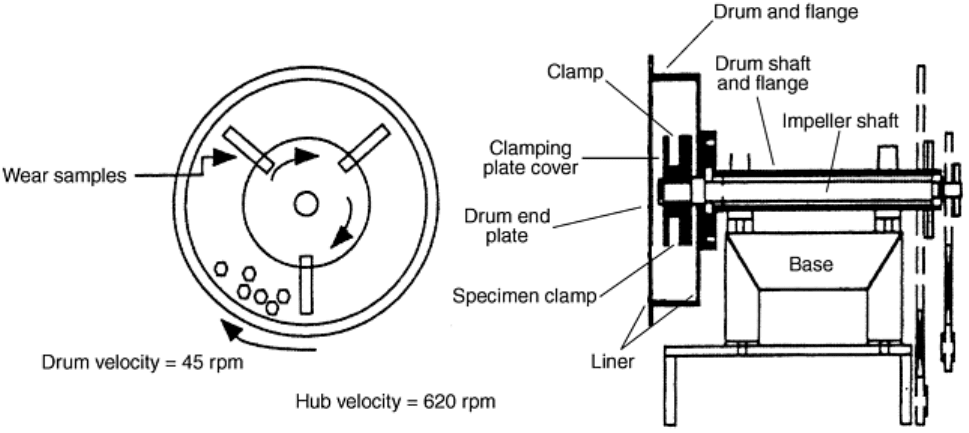
in-drum apparatus, which is also a nonstandard wear test. Unlike solid particle erosion, where the size of the
erosive particle is in the range of 10 to 100 μm, particle sizes using the impeller-in-drum are on the order of 25
to 30 mm (1.0 to 1.2 in.). Consequently, the size of the impact craters can be several hundred micrometers in
diameter.
Impeller-in-Drum Apparatus and Test Specimens. The impeller-in-drum wear test apparatus uses an impeller-
in-a- (rotating) drum arrangement (Fig. 10). The central impeller holds the three paddles, which impact the
abrasive media at a high linear velocity. The impeller and abrasive particles reside inside a nominally closed
and slowly rotating larger drum (a 3.0 mm, or 0.12 in., gap exists between the covering plate and the drum so
that the smaller wear debris can escape the drum during operation). When operating, the drum and the impeller
rotate in the same direction. The large drum, which is rubber lined (to both reduce noise and to provide some
friction between the drum and the abrasive particles), rotates slowly at 45 rpm, lifting the abrasive particles
until they overcome the frictional forces of the rubber lining and fall into the path of the rapidly rotating
paddles. The impeller-in-drum wear test apparatus uses three metal paddles as wear test specimens instead of
the one used in the Bond apparatus. These paddles are 75 × 25 × 12.5 mm (3 × 1 × 0.5 in.). Approximately 38
mm (1.5 in.) of the length of the paddle extends from the impeller hub assembly and is available for particle
impact. This translates into approximately 950 mm
2
of impact surface area. During operation, the paddles rotate
at 620 ± 5 rpm (a velocity equal to about 6 m/s at the tip of the paddle), causing them to impact against particles
of a hard abrasive mineral, for example, quartzite or granite or limestone. The abrasive particle-wear specimen
collisions cause wear to occur on the broad faces of the paddles from a combination of impact-type events as
well as from abrasion. The impeller-in-drum wear test provides quantitative information on the impact-abrasion
wear rate of the three test specimens through measurements of the mass loss before and after the wear test
schedule. Wear test variance is typically less than 10% for a duplicate set of specimens, although this test does
have the potential for greater wear variance than either the dry sand, rubber wheel or the pin-on-drum. (Note:
Certain safety precautions must also be exercised when using the impeller-in-drum wear test apparatus.
Because the test can cause a large amount of very fine particulate matter, when working with high silica
quartzite, ventilation through the use of a cyclone exhaust system, as well as through the use of a respirator or
small particle dust mask, is required. The silica-rich dust will irritate the mucus membranes in the throat and
nasal passages in the short term and can cause silicosis, a form of lung cancer, if exposed for longer times.)
Fig. 10 Schematic diagram of impeller-in-drum impact-abrasion wear apparatus. Source: Ref 61
Impeller-in-drum test procedures include a one hour procedure and a multihour procedure.
One Hour Test Procedure. The general test procedure for the impeller-in-drum starts with the sizing of abrasive
particles in the range of -25 to +19 mm (-1 to +0.75 in.). After this step, 0.6 kg of abrasive is measured, and the
number of particles that make up the charge is counted. Typically, for a 0.6 kg charge of high-silica quartzite,
the number of particles range from 38 to 44. The 0.6 kg charge is then loaded into the impeller and the cover is
bolted into place. An empty bag is positioned under the discharge chute to catch any abrasive debris that
escapes from the drum during operation and is not vented by the cyclone exhaust system. Typically, 30 to 50 g

of fines will escape from the drum during a 15 min milling run. The cyclone exhaust system collects and traps
the very finest dust. In this way, only the larger abrasive fragments are comminuted in the drum.
The drum and impeller are then set into motion. This marks the beginning of the first of two 1 h tests. The
speed of the impeller is adjusted to 620 rpm for the first 15 min interval. After the first 15 min test interval has
elapsed, the impeller and drum are stopped, the cover is removed, and the abrasive is collected. A fresh 0.6 kg
charge of abrasive is placed in the drum, and the procedure is repeated for a second 15 min interval. This is
done twice more, for a total running time of 1 h. During this time, the total amount of abrasive passed through
the impeller-in-drum system is 2.4 kg. After the first four 15 min tests, the paddle samples are removed,
thoroughly cleaned, and then hot-air dried. They are weighed to the nearest tenth of a milligram to determine
the mass loss. The specimen face is then reversed, and a duplicate series of four 15 min tests are run. The
results of these two series of tests are averaged and the standard deviation is calculated.
Multihour Test Procedure. In the multihour impeller-in-drum test, only one side of the sample is tested. In this
case, four or five 1 h test segments are run on one side of the specimen paddle in the same manner as the single
hour test. After each 1 h time period, the sample is removed, thoroughly cleaned, and weighed. It is then placed
back into the impeller-in-drum and another hour of testing is performed. In each case, fresh abrasive is placed
in the drum at 15 min intervals. For a 4 h test, 9.6 kg of abrasive is processed, while for the 5 h test, 12 kg of
abrasive is comminuted.
The results of the multihour test are presented in graphical form (i.e., a wear curve) in terms of the cumulative
mass or volume loss for the specimen as a function of time. In this way, the steady state wear impact-abrasion
wear rate can be determined, if one exists, from the linear portion of the mass/volume loss versus time curve.
Figure 11 shows examples of wear curves generated from impeller-in-drum wear tests.
Fig. 11 Wear curves of volume loss versus time for different materials worn against high silica quartzite.
Source: Ref 61
Previous research has shown that the 1 h impact-abrasion wear test represents an upper limit as far as the wear
rate is concerned (Ref 61). During the 1 h test, break-in is occurring during which the wear specimen conforms
to the wear environment. In this case, the sharp edges are being rounded and the surface is work hardening.
Development of the wear curves indicate that this process occurs during the first 1 to 2 h of the test, after which
the material reaches a steady state in terms of mass loss. Table 8 shows the results for both the 1 h impact-
abrasion test and the multiple hour test. Notice that the steady state wear rates are consistently lower than those
of the average of the 1 h tests.
Table 8 Typical impeller-tumbler wear data for ferrous alloys
Wear rate, mm
3
/h
Alloy and
designation
Hardness,
HV
1 h test 5 h test
Difference
(a)
,
%
304 stainless steel 207 112.2 102.3
-8.8
12% Mn steel 230 84.2 69.7
-17.2
ASTM A 514 256 101.3 96.7
-4.5
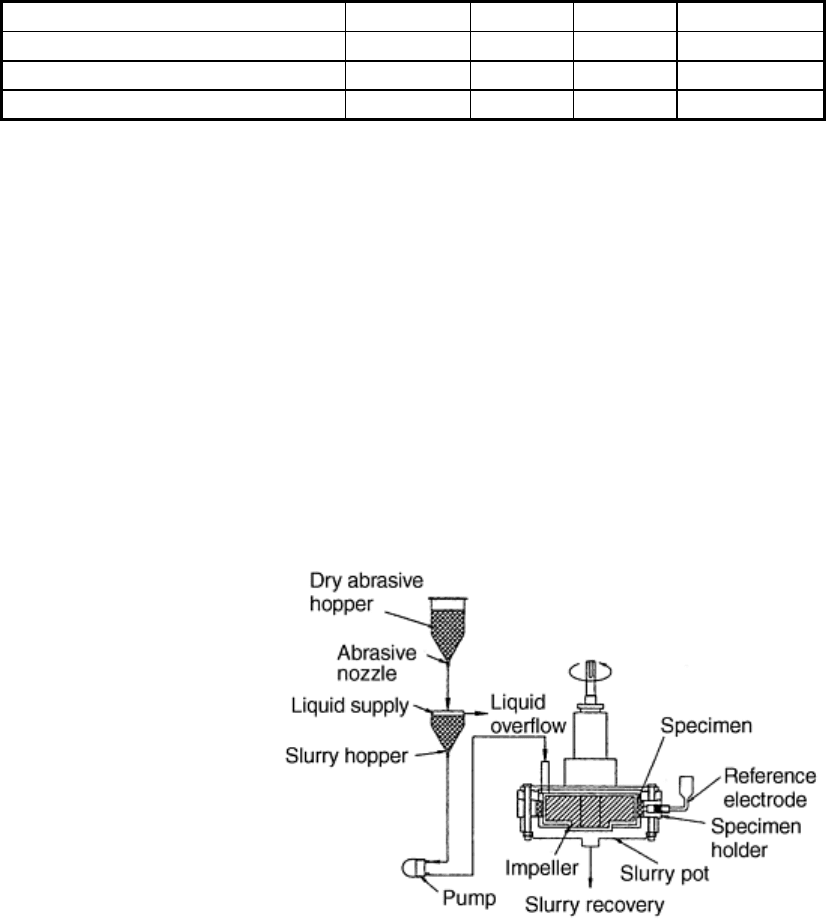
AISI 4340 540 96.2 76.6
-20.4
REM 500 505 93.7 81.0
-13.6
D2 tool steel 698 70.2 57.0
-18.8
High-chromium white cast iron
661 69.1 58.0 -16.1
(a) Comparison is made to the wear rate of that material after the first hour of testing.
Comparable to the jaw crusher test, the impeller-in-drum has the advantage of simulating more than one wear
mechanism (i.e., both abrasion and impact). The test also can use many different ores as abrasive particles, thus
matching the environment of the application more closely.
Slurry Abrasion Wear Testing
A slurry is a mixture of solid particles and a liquid (usually water) of a consistency that allows it to be pumped.
This mixture is by nature abrasive and causes extensive damage to pump housings and impellers, tee junctions,
elbows, and hydrocyclones. ASTM test method G 75 specifies a test for performing slurry abrasion tests (Ref
62). Other tests using slurries that allow different conditions from those in G 75 to be evaluated also have been
developed. These tests include low-angle slurry pot (Ref 63, 64, 65), pipeline (Ref 66, 67), and jet impingement
(Ref 68) type tests. All of these tests involve lowstress, two-body abrasive wear. One such device, illustrated in
Fig. 12, consists of a slurry pot with an impeller that rotates the slurry past an array of specimens located
around the inside of the pot (Ref 65, 69, 70, 71). In this apparatus, the impingement angle is low or nearly
tangential.
Fig. 12 Schematic diagram for slurry wear apparatus. Source: Ref 65, 69, 70, 71
ASTM G 75, or the Miller number, is used to determine the abrasivity of slurries, based on the rate of metal
loss from a standard 27% Cr white cast iron test block that reciprocates through any slurry, on a rubber lap,
with an imposed load of 22.2 N (5.0 lbf) placed on the 27% Cr white cast iron test block. The higher the Miller
number is, the more aggressive the slurry will be on the part. Although not specifically addressed in ASTM G
75, the effect of corrosion on the slurry abrasion process must be accounted for in the operation of any slurry-
handling system (Ref 72). Information on equipment, the specifics of the test procedure, and factors affecting
slurry abrasivity can be found in Ref 62.
A limitation on the Miller number is that it is based on a high-chromium white cast iron. Consequently, the
slurry-abrasion response (SAR) was developed so that different materials could be tested against a standard
slurry to see how they performed. In essence, the SAR is the determination of the Miller number in revere, and
it is based on the same Miller number procedure. This test tends to emphatically highlight the effects of
corrosion on a material for a particular slurry.
A slurry wear test apparatus of a general nature comprises a slurry pot and the equipment to feed the slurry to
the pot at a controlled rate. The feeding of slurry can be accomplished in one of two ways: flow-through mode
where the slurry passes through the system once and is discarded, and recirculating mode where the slurry is
passed through the system many times. In the recirculating mode of this slurry-pot apparatus, abrasive
degradation and wear debris contamination influence the wear rate over time. Figure 13 shows what can happen
when the slurry is recirculated, compared with when it passes through the system only one time. In general,
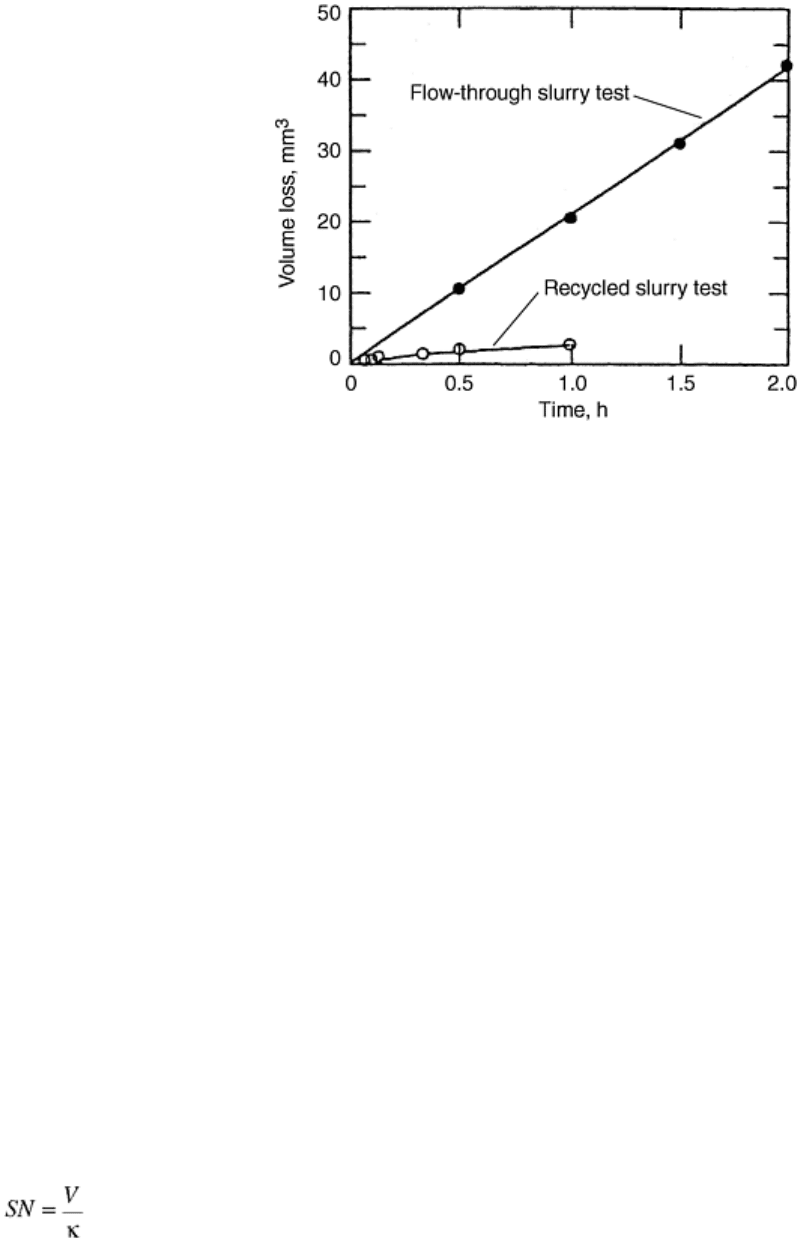
when the slurry passes through once, a linear volume loss-versus-time curve is generated. The wear rate will
vary with slurry loading (i.e., the solids concentration in the slurry), size of abrasive particle, angularity of the
abrasive particle, slurry flow rate, temperature, liquid composition and pH, and the material being tested. As in
other wear tests, the inclusion of reference standards is important to maintaining proper operation of the
equipment and normalizing the wear data between different material classes.
Fig. 13 Wear curves from slurry wear tests showing different wear rates when slurry is recirculated
versus a once-through test. Source: Ref 65
Microabrasion Wear Testing
The tests described to this point are typically used to determine the abrasive wear response of materials on a
macroscopic scale. Many advanced composites for abrasive wear applications consist of layered structures
where the outermost material is meant to be wear resistant, or are materials that have a hard or soft outer
coating. In these cases, a test is needed that can investigate the properties of the layer or coating without
complicating the result with the effect of the underlying material. In some cases, information on the wear
behavior of materials is needed where the abrasive interaction results from the contact of submicron to
nanometer scale particles with a surface (e.g., as in the effects of flow of a nanometer size slurry used for
polishing silicon wafers in the semiconductor industry).
Two different techniques for measuring microabrasion have been developed (Ref 73, 74, 75, 76, 77, 78, 79).
Both techniques use a cratering approach where the rotation of some tool in the presence of a fine abrasive
slurry results in the production of a circular depression. At some point during the test, the coating is worn
through, and a “bull's-eye” depression is seen where the substrate shows through. Using geometrical
relationships, the thickness of the coating can be determined. If the rotational speed of the tool, applied load,
and number of rotations (i.e., sliding distance) of the tool are accurately monitored, the wear rate can be
determined for the coating and underlying material. This is done by interrupting the test at different points in
the process and making visual measurements of the wear scar using optical or scanning electron microscopy
(SEM). Another way to measure the diameter and depth of the wear scar is to use a surface profilometer.
Although these testing techniques are relatively new, their importance grows as a result of efforts to create new
materials with wear-resistant hard surfaces for possible use as components in micron-scale machines.
By imposing a spherical geometry on the wear scar, the overall wear behavior can be described by a classical
model for abrasive wear:
(Eq 5)
where S is the total relative sliding distance between counterbody and specimen, N is the normal load on the
contact area, and V is the wear volume. κ is the wear coefficient and represents the wear properties of the
material.
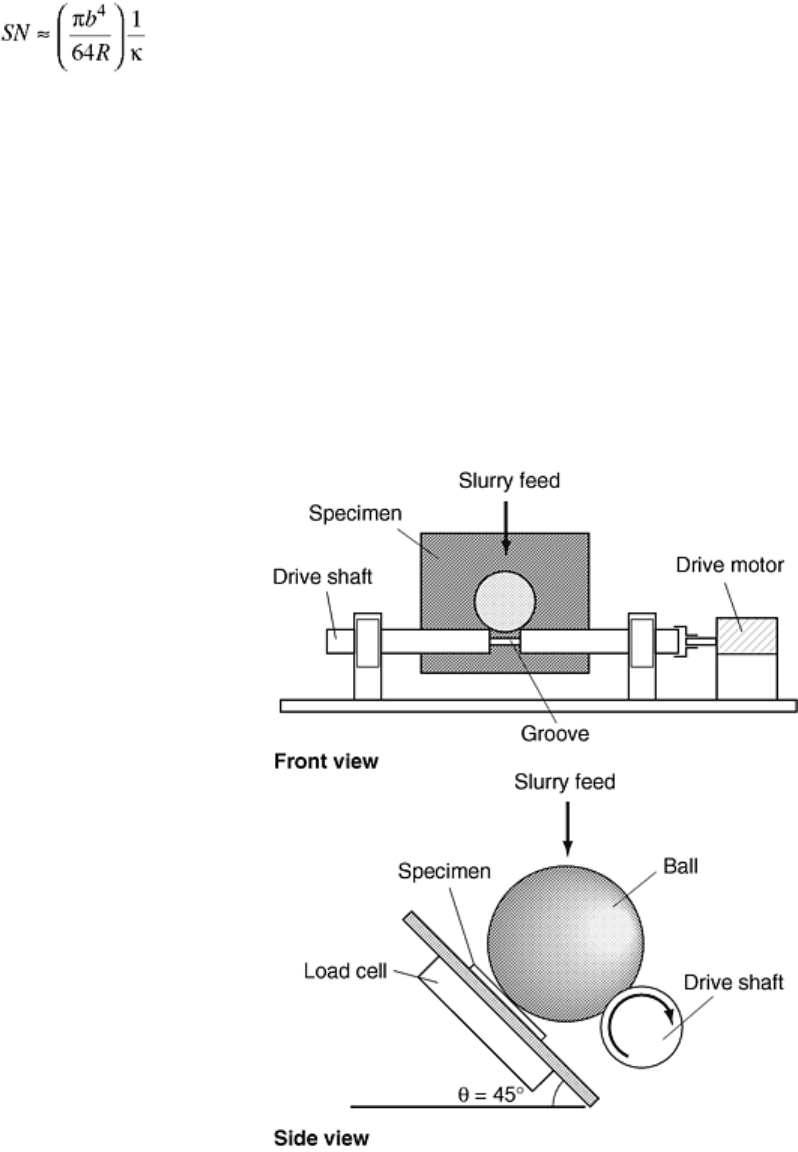
The imposed geometrical condition means that the wear volume can be calculated from a single measurement
of the wear scar diameter. The sliding distance is equal to the total number of revolutions of the spherical tool
multiplied by the circumference of the tool. Thus, in terms of measured quantities, Eq 5 becomes:
(Eq 6)
where b is the diameter of the circular wear scar, and R is the radius of the rotating spherical tool. Note,
however, that this equation is only valid for wear scar depths much less than R.
In one microabrasion test method (Ref 76, 77, 78, 79), a rotating steel sphere is pressed against the test
specimen in the presence of a slurry of small abrasive particles (Fig. 14). The steel sphere can be any diameter
but in these references is approximately 25 mm (1 in.). The abrasive slurry is typically an aqueous suspension
of small abrasive particles (e.g., 4 μm silicon carbide abrasive particles with an initial concentration of 0.75
g/cm
3
, although silica, alumina, diamond, or any other abrasive can be used in any desired concentration). The
sliding speed of the steel sphere can be varied from 30 to 150 rpm (i.e., 0.04 to 0.20 m/s for a 25 mm, or 1 in.,
steel sphere) to control the rate of wear, but a typical value is 0.05 m/s. The normal load can also be varied
(0.05–5 N, or 0.01–1.1 lbf), but a value of 0.18 N (0.04 lbf) is typical. The normal load is monitored by a load
cell. The wear coefficient can be calculated by measuring the progressive increase in the diameter of the wear
scar with respect to total sliding distance. The gradient of the linear relationship between wear volume and the
product of sliding distance and normal load yields the wear resistance of the material. Figure 15 shows one such
calculation.
Fig. 14 Schematic diagram of microabrasion ball cratering wear apparatus. Source: Ref 76

Fig. 15 Wear curves from microabrasion wear tests, mrad, milliradians. Source: Ref 76
References cited in this section
9. S. Jacobsson, M. Olsson, P. Hedenqvist, and O. Vingsbo, Scratch Testing, Friction, Lubrication, and
Wear Technology, Vol 18, ASM Handbook, ASM International, 1992, p 430–437
10. K.-H. Zum Gahr, Microstructure and Wear of Materials, Elsevier Science Publishers BV, Amsterdam,
Netherlands, 1987, p 132–350
11. E. Rabinowicz, Friction and Wear of Materials, 2nd ed., John Wiley & Sons, Inc., 1995, p 191–238
12. Ö.N. Doğan and J.A. Hawk, Effect of Carbide Orientation on Abrasion of High Cr White Cast Iron,
Wear, Vol 189, 1995, p 136–142
23. R. Blickensderfer and G. Laird III, A Pin-on-Drum Abrasive Wear Test And Comparison to other Pin
Tests, J. Test. Eval., Vol 16, 1988, p 516–526
27. “Standard Test Method for Pin Abrasion Testing,” G 132, Wear and Erosion: Metal Corrosion, Vol
03.02, ASTM
28. R. Blickensderfer, J.H. Tylczak, and B.W. Madsen, “Laboratory Wear Testing Capabilities of the
Bureau of Mines,” Bureau of Mines IC 9001, 1985, 36 pages
29. Ö.N. Doğan, J.A. Hawk, J.H. Tylczak, R.S. Wilson, and R.D. Govier, Wear of TiC Reinforced Metal
Matrix Composites, Wear, Vol 225–229, 1999, p 758–769
30. A.M. Häger and M. Davies, Short-Fibre Reinforced High-Temperature Resistant Polymers for a Wide
Field of Tribological Applications, Advances in Composite Tribology, Elsevier Science Publishers BV,
Amsterdam, Netherlands, 1973, p 115–116
31. J.A. Hawk and D.E. Alman, Abrasive Wear Behavior of NiAl and NiAl-TiB
2
Composites, Wear, Vol
225–229, 1999, p 544–556
32. Ö.N. Doğan, J.A. Hawk, and G. Laird II, Solidification Structure and Abrasion Resistance of High Cr
White Irons, Metall. Mater. Trans. A, Vol 28, 1997, p 1315–1328
33. C.P. Doğan and J.A. Hawk, Role of Composition and Microstructure in the Abrasive Wear of High-
Alumina Ceramics, Wear, Vol 225–229, 1999, p 1050–1058
